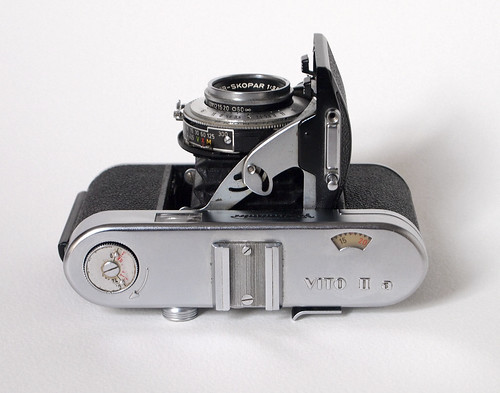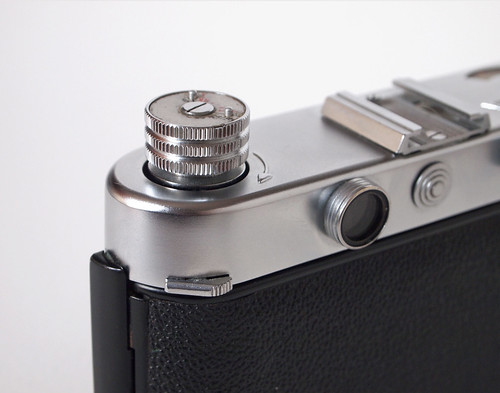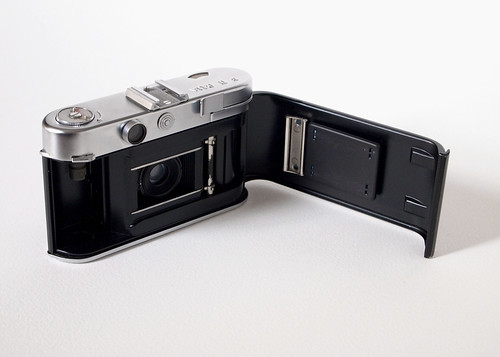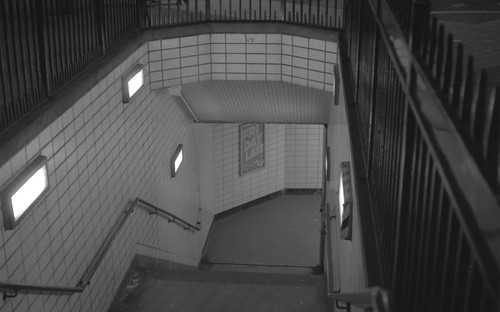 |
| Voigtländer Vito IIa |
Reputedly the last folding 35mm camera in production, Voigtländer's
Vito IIa was just one of many cameras the company produced bearing the Vito name. Introduced in 1955, the Vito IIa was a refinement of the
Vito II, which itself improved on the original pre-war Vito (the
Vito III was an altogether different rangefinder model). The Vito cameras also have specific model numbers to identify changes made to
the cameras during production: my example is a Type 135/99. The Vito IIa's production run overlapped with the rigid bodied Vito models which superseded the folding models: concurrent to the Vito IIa was the
Vito B, essentially a non-folding version of the camera, based on a very similar body, lens and shutter. (Although one suspects that folding cameras were more complex and therefore more expensive to make, which led to their disappearance in the market of 35mm cameras, interestingly, both folding and rigid bodied Vito cameras appear to have cost the same however, and the Vito B also offered the option of a faster lens). Common to the family of Vito cameras was the Color-Skopar lens. The original Skopar was Voigtländer's version of the
Tessar; the Color-Skopar, as its name suggests, was the post-war coated version. The folding Vito cameras all have a f3.5 Skopar or Color-Skopar 50mm lens.
 |
| Top view |
The improvements from the Vito II were not sufficiently groundbreaking to warrant an entirely new name for the camera: the significant changes are across the top plate of the camera, the Vito IIa gained a rapid advance lever, a rewind knob that's recessed into the top plate and an accessory shoe. The rewind knob pops up when it's released by a lever below to rewind the film. Releasing this when loading the camera also allows the button next to the viewfinder window to advance the film counter, which doesn't reset automatically.
 |
Rewind crank, released by the lever below;
film counter reset button on right hand side of viewfinder |
The camera opens by depressing a recessed button on the bottom plate. There's a small metal prop on the bottom of the door which functions as a stand when the camera is on a flat surface. Unusually, the shutter release and cable release socket are located on the top edge of the door, not on the top plate itself, an evolution from the original Vito's unusual bar release. In my experience, this provides a more comfortable position holding the camera, with the forefinger forward on the shutter release. To close the camera,
there are two tabs inside the door which need to be pushed down at the
same time. Loading the camera, the back opens with a sprung latch that runs the height of the camera back on the left hand side. There's a double-exposure prevention which releases when the film is advanced; this also prevents the shutter firing if there's no film inside, although in the shutter can still be cocked. The interlock depends on the roller with sprocket teeth being turned, which can be done manually without a film of course, to fire the shutter when the camera isn't loaded, to check the shutter, exercise it and so on.
 |
| Camera opened for loading |
The serial number on my camera dates the lens to 1958, which appears to be the last year of the Vito IIa's production. The other features that date it to the end of the Vito IIa's production run are the Prontor SVS shutter (it was also offered with the cheaper 4 speed Pronto shutter) with a new style run of shutter speeds - 1, 2, 4, 8, 15, 30, 60, 125, 300 (rather than 25, 50, 100 for example) and it also has a light-value (LV) system built into the shutter. This is a mechanism which links the shutter speed and aperture together by an arm which extends from the aperture ring to connect with teeth along the edge of the shutter speed ring. These settings are numbered (the red numbers in the picture below), and these would have related to numbers on exposure meters, meaning that the aperture and shutter speeds can be changed in sync to give the same exposure. In practice the LV mechanism is fairly easy to ignore when setting the aperture: simply by pulling the arm outwards when selecting an aperture disengages the connection, however to do this when setting shutter speed does need two hands. This doesn't seem to be an especially useful function now, but it was clearly an innovation at the time. The shutter also has PC flash sync and a V/X/M switch: the X and M settings are for flash, X for electronic flash, M for bulbs. The V setting is for a self-timer, missing on my camera.
 |
| LV mechanism around lens |
Focus is by estimation: there are markings on the distance scale around the lens between 10 and 12 feet (a triangle, presumably for group shots) and between 20 feet and 60 feet (a circle for distance shots). When folded, the Vito IIa has a streamlined profile, if somewhat compromised by the accessory shoe, and, although it's not much smaller than the
Kodak Retina for example (obviously it has no rangefinder), its rounded edges make for a more pocketable camera, or at least make it easier to get in and out of a pocket. In the examples below, the first shot on
Ilfodata document film is a good demonstration of the sharpness of the Color-Skopar lens; the third shot below was a long exposure taken without a tripod by standing the camera flat on a low wall.
 |
| Sample image on Ilfodata HS23 |
 |
| Sample image on HP5 Plus rated 1600 EI |
 |
| Sample image on FP4 rated 64 EI |
Edit 19/2/20: Further examples
 |
| Voigtländer Vito IIa with Ilford Mark V Motion Picture Negative Film |
 |
| Voigtländer Vito IIa with Ferrania P30 Alpha |
 |
| Voigtländer Vito IIa with Ilford Pan 100 |
 |
| Voigtländer Vito IIa with Foma Retropan Soft rated 650 |
Sources/further reading:
Vito IIa on Mike Elek's Classic Cameras
Vito IIa in Hans Lißberger's Voigtländer Collection (in German)












Excellent text on this (forgotten) little folder, concise yet comprehensive. I own two Vito IIa's of different vintage (from very early and late production batches); just love them, their minimalistic design and ease of use. My congratulations for the great results you got using your Vito IIa; I never used Ilfodata film, but I might give it a try soon. Thanks!
ReplyDeleteCheers,
R. Vieira
Excellent article on this camera. Very detailed and helpful. Thanks and very good photos taken with it too :). Kind regards...Paul.
ReplyDeleteThanks for the comments. The Vito IIa I found to be a really good manual, mechanical 35mm viewfinder camera, with the added benefit of folding for compactness. The later, non-folding Vito cameras although they do have their own charms, just aren't as beautifully designed.
ReplyDeleteThanks for your answer. Yes, we all agree on the Vito IIa. It is a very underrated example of excellent industrial design from the 50s. I own a mint and fully functional Zeiss Ikon Ikonta 35, a competitor of the Vito IIa from the same era, and while I tend to like all the 35mm and 120 cameras designed by Hubert Nerwin on behalf of Zeiss Ikon, the Vito still wins hands down thanks to its ergonomy and minimalist lines.
ReplyDeleteI fully agree with you on the later, non-folding Vito cameras.